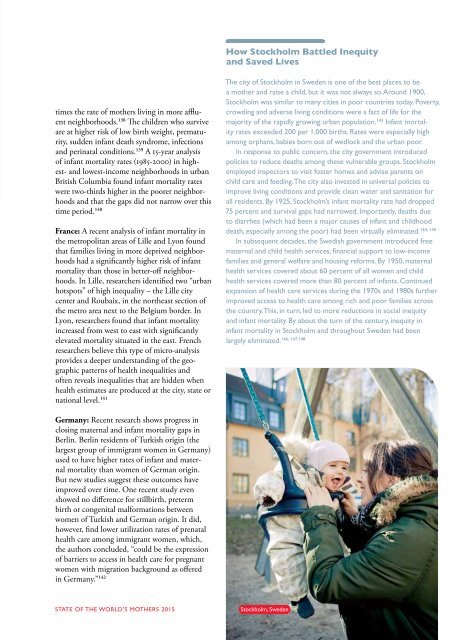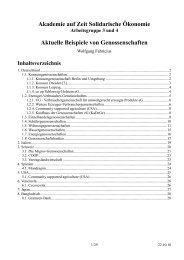sowm_2015__int__africa_full_report_low_res
sowm_2015__int__africa_full_report_low_res
sowm_2015__int__africa_full_report_low_res
You also want an ePaper? Increase the reach of your titles
YUMPU automatically turns print PDFs into web optimized ePapers that Google loves.
How Stockholm Battled Inequity<br />
and Saved Lives<br />
times the rate of mothers living in more affluent<br />
neighborhoods. 138 The children who survive<br />
are at higher risk of <strong>low</strong> birth weight, prematurity,<br />
sudden infant death syndrome, infections<br />
and perinatal conditions. 139 A 15-year analysis<br />
of infant mortality rates (1985-2000) in highest-<br />
and <strong>low</strong>est-income neighborhoods in urban<br />
British Columbia found infant mortality rates<br />
were two-thirds higher in the poorer neighborhoods<br />
and that the gaps did not narrow over this<br />
time period. 140<br />
France: A recent analysis of infant mortality in<br />
the metropolitan areas of Lille and Lyon found<br />
that families living in more deprived neighborhoods<br />
had a significantly higher risk of infant<br />
mortality than those in better-off neighborhoods.<br />
In Lille, <strong>res</strong>earchers identified two “urban<br />
hotspots” of high inequality – the Lille city<br />
center and Roubaix, in the northeast section of<br />
the metro area next to the Belgium border. In<br />
Lyon, <strong>res</strong>earchers found that infant mortality<br />
increased from west to east with significantly<br />
elevated mortality situated in the east. French<br />
<strong>res</strong>earchers believe this type of micro-analysis<br />
provides a deeper understanding of the geographic<br />
patterns of health inequalities and<br />
often reveals inequalities that are hidden when<br />
health estimates are produced at the city, state or<br />
national level. 141<br />
The city of Stockholm in Sweden is one of the best places to be<br />
a mother and raise a child, but it was not always so. Around 1900,<br />
Stockholm was similar to many cities in poor countries today. Poverty,<br />
crowding and adverse living conditions were a fact of life for the<br />
majority of the rapidly growing urban population. 143 Infant mortality<br />
rates exceeded 200 per 1,000 births. Rates were especially high<br />
among orphans, babies born out of wedlock and the urban poor.<br />
In <strong>res</strong>ponse to public concern, the city government <strong>int</strong>roduced<br />
policies to reduce deaths among these vulnerable groups. Stockholm<br />
employed inspectors to visit foster homes and advise parents on<br />
child care and feeding. The city also invested in universal policies to<br />
improve living conditions and provide clean water and sanitation for<br />
all <strong>res</strong>idents. By 1925, Stockholm’s infant mortality rate had dropped<br />
75 percent and survival gaps had narrowed. Importantly, deaths due<br />
to diarrhea (which had been a major causes of infant and childhood<br />
144, 145<br />
death, especially among the poor) had been virtually eliminated.<br />
In subsequent decades, the Swedish government <strong>int</strong>roduced free<br />
maternal and child health services, financial support to <strong>low</strong>-income<br />
families and general welfare and housing reforms. By 1950, maternal<br />
health services covered about 60 percent of all women and child<br />
health services covered more than 80 percent of infants. Continued<br />
expansion of health care services during the 1970s and 1980s further<br />
improved access to health care among rich and poor families across<br />
the country. This, in turn, led to more reductions in social inequity<br />
and infant mortality. By about the turn of the century, inequity in<br />
infant mortality in Stockholm and throughout Sweden had been<br />
146, 147,148<br />
largely eliminated.<br />
Germany: Recent <strong>res</strong>earch shows prog<strong>res</strong>s in<br />
closing maternal and infant mortality gaps in<br />
Berlin. Berlin <strong>res</strong>idents of Turkish origin (the<br />
largest group of immigrant women in Germany)<br />
used to have higher rates of infant and maternal<br />
mortality than women of German origin.<br />
But new studies suggest these outcomes have<br />
improved over time. One recent study even<br />
showed no difference for stillbirth, preterm<br />
birth or congenital malformations between<br />
women of Turkish and German origin. It did,<br />
however, find <strong>low</strong>er utilization rates of prenatal<br />
health care among immigrant women, which,<br />
the authors concluded, “could be the exp<strong>res</strong>sion<br />
of barriers to access in health care for pregnant<br />
women with migration background as offered<br />
in Germany.” 142<br />
STATE OF THE WORLD’S MOTHERS <strong>2015</strong> Stockholm, Sweden<br />
43




